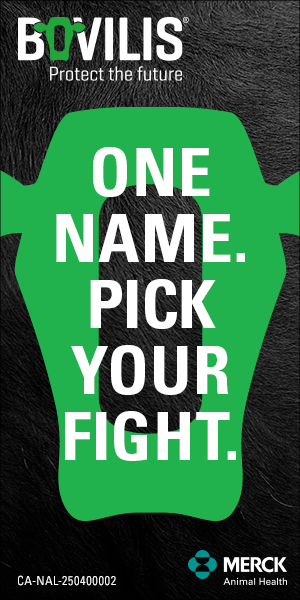AB Direct - Steers
Rail: 496.00-500.00 del
AB Direct - Heifers
Rail: 496.00-500.00 del
US Trade- Steers
Rail: 368.00-370.00 (IA, NE)
US Trade - Heifers
Rail: 368.00-370.00 (IA, NE)
Canadian Dollar
0.22

Three insights on creating greater value through production data
Opportunities to unlock premiums through production data are growing, but it’s not a sure thing yet.
It can be challenging for cow-calf producers to properly leverage this data when marketing their calves, even as more feeders are sourcing calves based on production data.
“The downside is that in the current environment and the current market dynamics, it is relatively tough to do that at scale,” said Virgil Lowe, who manages Granite Cattle Inc., a small feeding company at Nanton, Alberta, during a recent Beef Cattle Research Council (BCRC) webinar.
While it’s too early to guarantee that production data will result in a bigger cheque come sale day, Lowe said it’s moving in that direction, with feeders looking for more detailed, accurate health and performance information on the calves they purchase.
Here are three key insights from this webinar on creating greater value from your calves using production data:
Most data-tracking tools are underused.
Despite the numerous options for tracking production data at the cow-calf level, the webinar’s panelists agreed that producers aren’t taking advantage of most of these tools, with potential value being lost.
Betty-Jo Almond, General Manager of AgSights, is no stranger to the wide variety of data-capture tools available to livestock producers. AgSights, an Ontario-based company, offers genetic evaluations and data management programs for several species.
“We believe that data has value,” said Almond. “When you can identify the animals that do a good job or those silently strong animals and the ones that are not doing great for you and cull those, then you can really see some pretty quick advancements in your profitability.”
AgSight’s bioTrack Plus livestock data management program, for example, is one such tool that tracks animals from birth to sale with the goal of increasing profitability. The program includes livestock identification, herd inventory, record keeping, traceability, and health management.
While producers may be familiar with this type of record-keeping program, there are other innovative ways to capture data at the cow-calf level that is valuable to feeders. Almond discussed the carcass ultrasound service provided by AgSights for live cattle, which hasn’t seen great uptake yet.
“That ultrasound offers almost like a best-before,” she explained. “You put in your marbling targets and goals, and then you scan animals, and the module actually predicts how many more days you should feed that animal in order to reach that target marbling and ribeye size and grade.”
Market your data to make it pay.
The key to leveraging production data is to share it with potential buyers early enough so you can get a better price when your calves go through the ring.
“If it’s not provided early enough before the time when the buyer has to basically determine their price, they can’t use it,” said Lowe.
“That’s the problem with telling the auctioneer to announce it off the block—unless it’s pretty generic, easily understandable, and verifiable information, it’s quite hard to extract extra value out of it without providing it any earlier.”
Finding buyers who are seeking this data can be difficult, said Bruce Niznik, who ranches west of Brooks, AB. With the help of the Canadian Angus Association, Niznik used genetic information on his Black Angus herd to create a feeder calf index, which includes EPDs on performance traits. Using this index, he worked with the purebred breeder he buys bulls from and his auction market representative to connect with feeders willing to pay more for his calves.
Niznik also enlisted the help of his vaccine representative to connect with feedlots specifically looking for calves vaccinated with these products.
“The buyers for our cattle are looking for specific types of vaccine in them, and we’re precise when we describe the cattle,” said Niznik.
“(The vaccine rep) knows the feedlots that have contacted him that are looking for the vaccination programs we’re using, and he contacts them whenever we’re selling calves.”
Start now to get higher-quality data and greater value in the future.
To ensure greater accuracy of production data and performance predictions, the best time to begin tracking data is now.
“Accuracy comes from having a large amount of historical high-quality data,” said Lowe.
“Whether or not your particular operation is able to monetize their data collection practices today, it’s still worth starting to do that because starting that process today will deliver higher-quality data…which means more accuracy in terms of the performance projections and better results for your future buyer, and therefore more reliability that they’re going to come back and want to pay more next year.”


